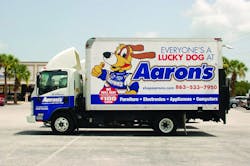Company: Aaron’s Inc., Atlanta, GA
Operation: National lease-to-own specialty retailer of furniture, consumer electronics, and home appliances and accessories
Problem:
With some 2,100 company-operated and franchised stores in the U.S. and Canada, the Aaron’s retail brand is easily recognizable these days and is known for providing flexible ways to purchase a variety of home goods. But the company needed better data from and control of its trucks.
The Aaron’s fleet includes several hundred Class 8 tractors and Class 6 box trucks, but the bulk of its fleet consists of about 2,500 Class 3-5 box trucks and 500 Class 1 and 2 vans. “With Aaron’s, we might have a store that has eight associates, and seven of those associates can potentially drive a delivery truck,” says Lewis Allen, senior manager of fleet operations.
The fleet looked into a GPS and truck monitoring system and its ability to automate driver identification.
The company’s initial idea was to track truck utilization, Allen notes, and the GPS product also had to be low cost, simple to install, and allow for expanded functionality down the line. It also needed to meet the retailer’s unique requirements and boost driver buy-in and retention.
Additionally, Aaron’s was looking to improve driver behaviors with positive reinforcement.
Solution:
After piloting a GPS and telematics system about five years ago that focused on problem driving, Aaron’s was ready to try something else. In October 2013, the company began a larger pilot and subsequent rollout of the so-called social telematics and GPS system from Azuga in San Jose, CA.
Allen says he and other associates went to various stores and installed the Azuga product themselves. “It’s just a little 2 in. x 2 in. box. It’s really easy—you plug it right into the OBD-II port and zip-tie it on,” he tells Fleet Owner. “That way, if the truck goes in for service and they unplug it to do diagnostics, it won’t get lost and they can just plug [the Azuga device] back in.”
The Azuga system uses cloud-based software to lower costs, but the firm’s “special sauce” that sets it apart is its driver-centric, rewards-based approach, says Ananth Rani, president and co-founder of Azuga.
Social telematics as a concept is still taking shape. According to Rani, a rewards program could involve a manager sending a gift card to a good driver’s smartphone and could deliver other recognition, too, such as pinning an award icon to the driver’s LinkedIn profile or including the driver in a public or private LinkedIn group of recipients.
Or it could help a driver improve after a poor performance, such as allowing a driver to get some extra credit on a low rewards score by watching a corrective training video on his or her smartphone.
“We’re looking at how we can use all the data to help us, and we’re trying to change driver behaviors,” Allen says. “One part of that is to incentivize them to do the right thing. Let’s let them compete against each other. Who’s going to get that reward at the end of the week, month or quarter?
“What we’re doing with the technology right now is to really just track it and when necessary, we’ll have that counseling discussion with our drivers,” Allen continues. So while there’s the familiar reprimand when needed, the idea is to structure the truck/driver monitoring program like a game, with the desired measures being things like less idling, less speeding, fewer accidents, and better fuel economy.
So far, so good. Anecdotally, Allen says the technology is showing some positive results. “I do still see vehicle accidents, but I’m definitely seeing fewer serious accidents,” he contends. “To me, it’s not only having this technology, now you have to use it to its potential.”
About the Author
Aaron Marsh
Aaron Marsh is a former senior editor of FleetOwner, who wrote for the publication from 2015 to 2019.
